|
Accounting | Business | Computer Science | General Studies | Math | Sciences | Civics Exam | Help/Support | Join/Cancel | Contact Us | Login/Log Out Calculus For Business
Test 2 
Solution (1.9)2 + 8(1.9) – 2 = 16.810 (1.99)2 + 8(1.99) – 2 = 17.880 and so on Complete the table and use the result to find the indicated limit. 
Solution Enter in ti-nspire or ti84 plus exactly like so (.94 – 1) ÷ (.9 – 1) = 3.439 (.99 - 1) ÷ .99 – 1) = 3.940 And so on… Use the properties of limits to help decide whether the limit exists. If the limit exists, find its value. 
Solution Simplify x2 – 9 / x – 3 = x / x2 = x and -9 / -3 = 3 Now put the equation back together = x + 3 Now plug in the value of x --> 3 (3) + 3 = 6 Use the properties of limits to help decide whether the limit exists. If the limit exists, find its value. 
The Ti-nspire will solve this problem if you are allowed to use it. Otherwise, solve like so Solution Simplify x + 6 + 5 x + 1 Now plug in the value of (x à-5) 1 – 5 = -4 Use the properties of limits to help decide whether the limit exists. If the limit exists, find its value. 

Solution divide by the highest denominator power  = = 
Use the properties of limits to help decide whether the limit exists. If the limit exists, find its value. 
Solution divide by the highest denominator power 
The average cost per tape, denoted by c (x) is found by dividing c(x) by x. Find lim c(x) x--> 2.000 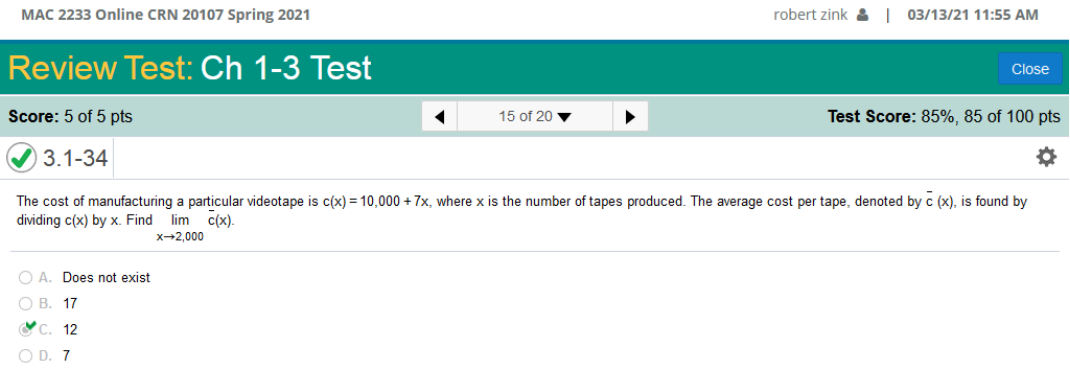
The equation we need to write is 
Then we plug in all the values of x = 2,000 10,000 + 7(2,000) ÷ 2,000 10,000 + 14,000 ÷ 2,000 24,000 ÷ 2,000 = 12 Find all values x = a where the function is discontinuous. 
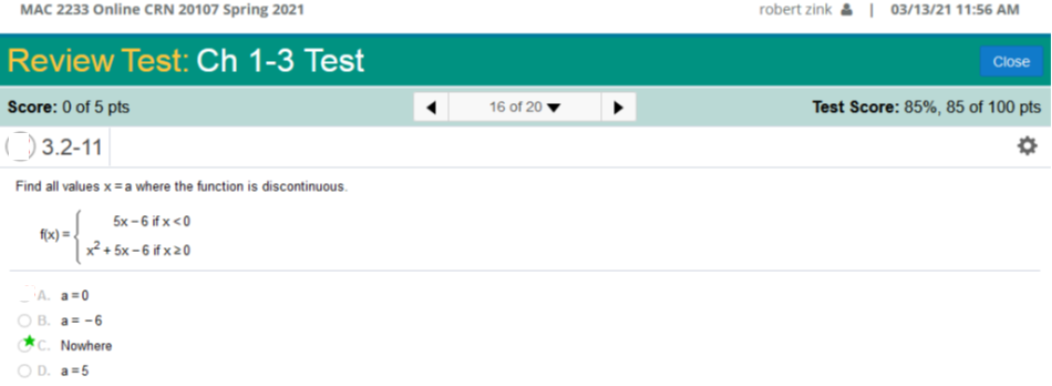
Find the average rate of change for the function over the given interval. y = x2 + 4x between x = 4 and x = 8. 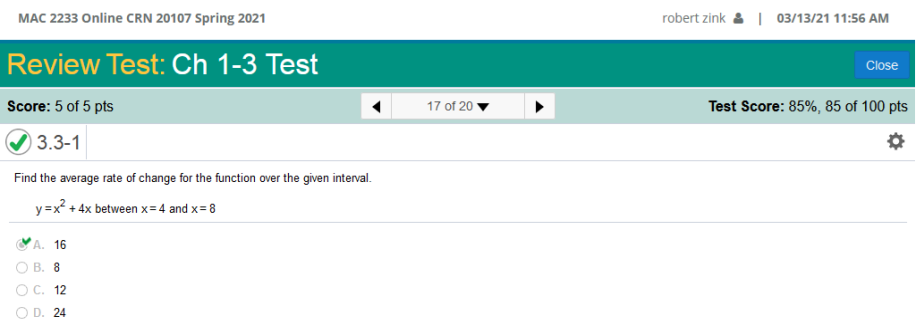
Solve the long way… 64 + 32 – 16 + -16 = 96 – 32 = 64 64 / 8 – 4 = 64 / 4 = 16 Or This is a cool online calculator that will solve this problem for you. https://www.emathhelp.net/calculators/calculus-1/average-rate-of-change-calculator/ enter equation and points. 
Find f’(x) at the given value of x. f(x) x2 – 9x + 2, find f’(- 4). 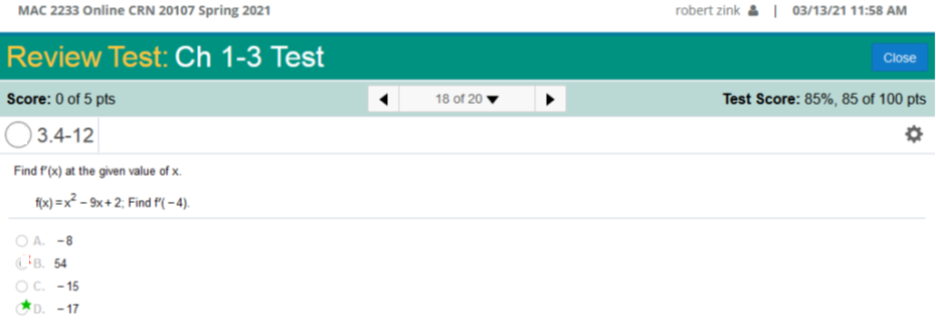
Solve the long way… nn-1 (n = the exponent) If a variable has no exponent, then the variable is cancelled out. For example, with 2x, the derivative would = 2 because the exponent is equal to 1 and n-1 would cancel it out. If a number in an equation has no variable, then the derivative = 0. What I do is I always do is multiply a number with no variable by 0 when finding the derivative. For example, 1, the derivative = 0 (you do not need to represent the 0) So, the derivative of x2 – 9x + 2 is: 2(x2 – 1) – 1(91 – 1) + 2(0) 2x – 9 2(-4) – 9 = -8 – 9 = -17 Or This calculator will find the derivative for you. https://www.derivative-calculator.net/ 
Using the definition of the derivative, find f’(x). Then find f’(1), f’(2) and f’(3) when the derivative exists. f(x) = -x2 + 9x - 4 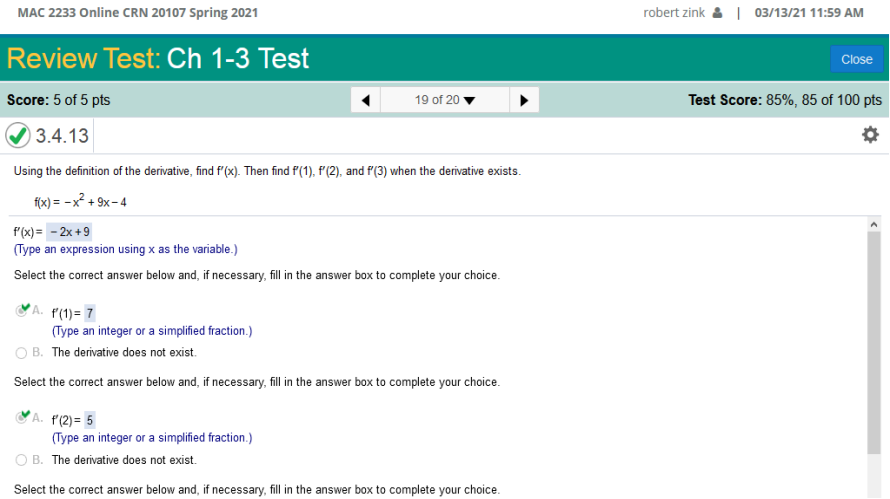 
Solve Find the derivative of f(x) = -x2 + 9x – 4 (which is -2x + 9) and plug in the values of f’(1) which is 1, f’(2) which is 2 and f’(3) which is 3. This is the same as above, except you need to find the derivative and find multiple values for f’(). solve the long way. nn-1 (n = the exponent) The same rules apply as above. nn-1(-x2 + 9x – 4) = 2(x2 – 1) + 9(x1 – 1) – 4(0) = -2x + 9 Now plug in all the values of f’() which are 1, 2, & 3. -2(1) + 9 = -2 + 9 = 7 -2(2) + 9 = -4 + 9 = 5 -2(3) + 9 = -6 + 9 = 3 This calculator will find the derivative for you. https://www.derivative-calculator.net/ and enter in the equation as so 
the price of the item. Find the rate of change of demand with respect to price. 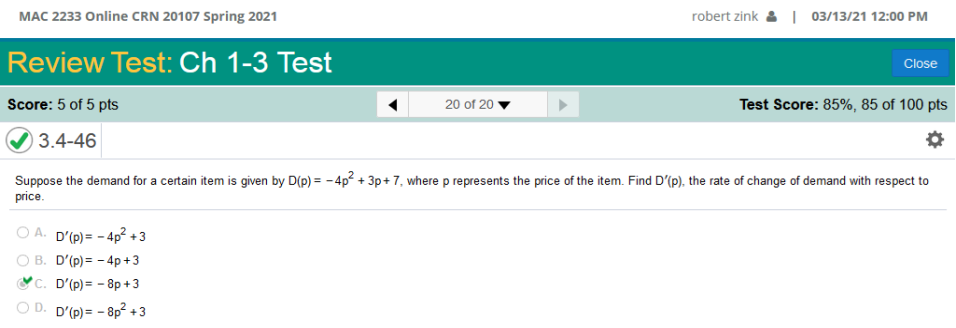
We need to find the demand which is simply the derivative in this case. The book gave long lessons on finding the demand however after I solved about a dozen of the problems, I came to realize that the demand was simply the derivative of the expression and the variable used is p instead of x. Imagine the time I saved after that! Find the derivative of -4p2 + 3p + 7 = -8p + 3 The same rule applies as above. nn – 1(-4p2 + 3p +7) = 2(-4p2 – 1) + 3(p1 – 1) + 7(0) D’(p)-8p + 3 It is as simple as that! Homework Chapter 1A 1B 2A 2B 3A 3B 4A 4B 5A 6A Chapter Tests 1 2 3 4 5 6 7 FINAL EXAM | Need A Tutor? | Need Homework Help?
|
| Home |
Accounting & Finance | Business |
Computer Science | General Studies | Math | Sciences |
Civics Exam |
Everything
Else |
Help & Support |
Join/Cancel |
Contact Us |
Login / Log Out |